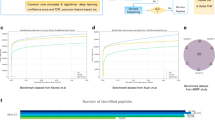Abstract
Mass spectrometry has emerged as the method of choice for the exploration of the immunopeptidome. Insights from the immunopeptidome promise novel cancer therapeutic approaches and a better understanding of the basic mechanisms of our immune system. To meet the computational demands from the steady gain in popularity and reach of mass spectrometry-based immunopeptidomics analysis, we created the SysteMHC Atlas project, a first-of-its-kind computational pipeline and resource repository dedicated to standardizing data analysis and public dissemination of immunopeptidomic datasets.
Access this chapter
Tax calculation will be finalised at checkout
Purchases are for personal use only
Similar content being viewed by others
References
Shastri N, Schwab S, Serwold T (2002) Producing nature’s gene-chips: the generation of peptides for display by MHC class I molecules. Annu Rev Immunol 20(1):463–493
Kambayashi T, Laufer TM (2014) Atypical MHC class II-expressing antigen-presenting cells: can anything replace a dendritic cell? Nat Rev Immunol 14(11):719
Falk K, Rötzschke O, Stevanovié S et al (1991) Allele-specific motifs revealed by sequencing of self-peptides eluted from MHC molecules. Nature 351(6324):290
Hunt DF, Henderson RA, Shabanowitz J et al (1992) Characterization of peptides bound to the class I MHC molecule HLA-A2.1 by mass spectrometry. Science 255(5049):1261–1263
Rammensee H-G, Friede T, Stevanović S (1995) MHC ligands and peptide motifs: first listing. Immunogenetics 41(4):178–228
Caron E, Kowalewski DJ, Koh CC et al (2015) Analysis of major histocompatibility complex (MHC) immunopeptidomes using mass spectrometry. Mol Cell Proteomics 14(12):3105–3117
Liepe J, Marino F, Sidney J et al (2016) A large fraction of HLA class I ligands are proteasome-generated spliced peptides. Science 354(6310):354–358
Gillet LC, Navarro P, Tate S et al (2012) Targeted data extraction of the MS/MS spectra generated by data-independent acquisition: a new concept for consistent and accurate proteome analysis. Mol Cell Proteomics 11(6):O111. 016717
Ludwig C, Gillet L, Rosenberger G et al (2018) Data-independent acquisition-based SWATH-MS for quantitative proteomics: a tutorial. Mol Syst Biol 14(8):e8126
Caron E, Espona L, Kowalewski DJ et al (2015) An open-source computational and data resource to analyze digital maps of immunopeptidomes. elife 4:e07661
Schuster H, Shao W, Weiss T et al (2018) A tissue-based draft map of the murine MHC class I immunopeptidome. Scientific data 5:180157
Bassani-Sternberg M, Bräunlein E, Klar R et al (2016) Direct identification of clinically relevant neoepitopes presented on native human melanoma tissue by mass spectrometry. Nat Commun 7:13404
Faridi P, Li C, Ramarathinam SH et al (2018) A subset of HLA-I peptides are not genomically templated: evidence for cis-and trans-spliced peptide ligands. Sci Immunol 3(28):eaar3947
Bassani-Sternberg M, Coukos G (2016) Mass spectrometry-based antigen discovery for cancer immunotherapy. Curr Opin Immunol 41:9–17
Faridi P, Purcell AW, Croft NP (2018) In immunopeptidomics we need a sniper instead of a shotgun. Proteomics 18(12):1700464
Shao W, Pedrioli PG, Wolski W et al (2017) The SysteMHC atlas project. Nucleic Acids Res 46(D1):D1237–D1247
Shao W, Lam H (2017) Tandem mass spectral libraries of peptides and their roles in proteomics research. Mass Spectrom Rev 36(5):634–648
Pedrioli PG (2010) Trans-proteomic pipeline: a pipeline for proteomic analysis. In: Proteome bioinformatics. Springer, New York, NY, pp 213–238
Pedrioli PG, Eng JK, Hubley R et al (2004) A common open representation of mass spectrometry data and its application to proteomics research. Nat Biotechnol 22(11):1459
Chambers MC, Maclean B, Burke R et al (2012) A cross-platform toolkit for mass spectrometry and proteomics. Nat Biotechnol 30(10):918
Eng JK, Jahan TA, Hoopmann MR (2013) Comet: an open-source MS/MS sequence database search tool. Proteomics 13(1):22–24
Fenyö D, Beavis RC (2003) A method for assessing the statistical significance of mass spectrometry-based protein identifications using general scoring schemes. Anal Chem 75(4):768–774
Elias JE, Gygi SP (2007) Target-decoy search strategy for increased confidence in large-scale protein identifications by mass spectrometry. Nat Methods 4(3):207
Keller A, Nesvizhskii AI, Kolker E et al (2002) Empirical statistical model to estimate the accuracy of peptide identifications made by MS/MS and database search. Anal Chem 74(20):5383–5392
Shteynberg D, Deutsch EW, Lam H et al (2011) iProphet: multi-level integrative analysis of shotgun proteomic data improves peptide and protein identification rates and error estimates. Mol Cell Proteomics 10(12):M111. 007690
Karosiene E, Lundegaard C, Lund O et al (2012) NetMHCcons: a consensus method for the major histocompatibility complex class I predictions. Immunogenetics 64(3):177–186
Lam H, Deutsch EW, Eddes JS et al (2008) Building consensus spectral libraries for peptide identification in proteomics. Nat Methods 5(10):873
Shao W, Lam H (2013) Denoising peptide tandem mass spectra for spectral libraries: a Bayesian approach. J Proteome Res 12(7):3223–3232
Acknowledgments
The authors wish to thank the whole Aebersold lab for their support and critical discussion.
Author information
Authors and Affiliations
Corresponding authors
Editor information
Editors and Affiliations
Rights and permissions
Copyright information
© 2020 Springer Science+Business Media, LLC, part of Springer Nature
About this protocol
Cite this protocol
Shao, W., Caron, E., Pedrioli, P., Aebersold, R. (2020). The SysteMHC Atlas: a Computational Pipeline, a Website, and a Data Repository for Immunopeptidomic Analyses. In: Boegel, S. (eds) Bioinformatics for Cancer Immunotherapy. Methods in Molecular Biology, vol 2120. Humana, New York, NY. https://doi.org/10.1007/978-1-0716-0327-7_12
Download citation
DOI: https://doi.org/10.1007/978-1-0716-0327-7_12
Published:
Publisher Name: Humana, New York, NY
Print ISBN: 978-1-0716-0326-0
Online ISBN: 978-1-0716-0327-7
eBook Packages: Springer Protocols




